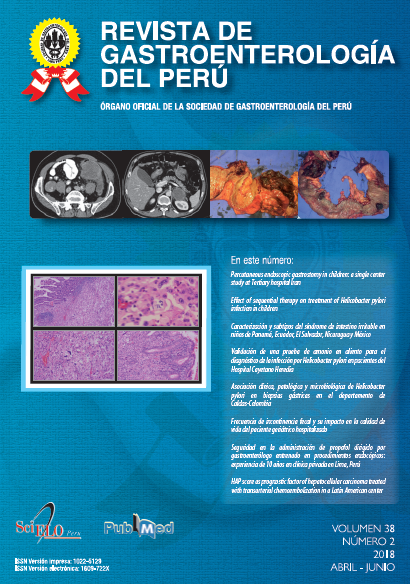Percutaneous endoscopic gastrostomy in children: a single center study at Tertiary hospital Iran
DOI:
https://doi.org/10.47892/rgp.2018.382.881Palabras clave:
Endoscopy, Gastrostomy, ChildResumen
Introduction: The aim of this study was to evaluate complications after percutaneous endoscopic gastrostomy among children who underwent percutaneous endoscopic gastrostomy in Nemazee hospital. Materials and methods: All children who underwent percutaneous endoscopic gastrostomy were included in the current study. Place of the study was department of pediatric gastroenterology of Nemazee children hospital of Shiraz university of medical sciences. Duration of the study was 5 year starting from 2008. All drugs such as aspirin, NSAIDS, and heparin were discontinued 1-7 days before procedures. All patients were kept NPO 6-8 hours before procedure according to the age. Single dose antibiotic was prescribed for all cases before procedure. During procedure, all patients were sedated using propofol and or midazolam. Some patients required intubation. Results: Of 39 cases who underwent PEG, 4 (10.2%) patients showed complication. The most common indication for PEG insertion were neurologic problem (84.6%) and metabolic disease (10.2%). Of our patients, 84.6% of the cases had the weight below third percentile. Conclusion: The most common indication for percutaneous endoscopic gastrostomy was cerebral palsy. The complication rate in our study was 10.2%. Celulitis was the most common complication.Descargas
Los datos de descargas todavía no están disponibles.
Métricas
Cargando métricas ...
Descargas
Publicado
10.08.2018
Cómo citar
1.
Mohsen Dehghani S, Haghighat M, Nematollahi F, Javaherizadeh H, Honar N, Bahmanyar M, Ataollahi M. Percutaneous endoscopic gastrostomy in children: a single center study at Tertiary hospital Iran. Rev Gastroenterol Peru [nternet]. 10 de agosto de 2018 [citado 18 de diciembre de 2025];38(2):125-7. isponible en: https://revistagastroperu.com/index.php/rgp/article/view/881
Número
Sección
ARTÍCULOS ORIGINALES
Licencia
Revista de Gastroenterología del Perú by Sociedad Peruana de Gastroenterología del Perú is licensed under a Licencia Creative Commons Atribución 4.0 Internacional..
Aquellos autores/as que tengan publicaciones con esta revista, aceptan los términos siguientes:
- Los autores/as conservarán sus derechos de autor y garantizarán a la revista el derecho de primera publicación de su obra, el cuál estará simultáneamente sujeto a la Licencia de reconocimiento de Creative Commons que permite a terceros compartir la obra siempre que se indique su autor y su primera publicación esta revista.
- Los autores/as podrán adoptar otros acuerdos de licencia no exclusiva de distribución de la versión de la obra publicada (p. ej.: depositarla en un archivo telemático institucional o publicarla en un volumen monográfico) siempre que se indique la publicación inicial en esta revista.
- Se permite y recomienda a los autores/as difundir su obra a través de Internet (p. ej.: en archivos telemáticos institucionales o en su página web) antes y durante el proceso de envío, lo cual puede producir intercambios interesantes y aumentar las citas de la obra publicada. (Véase El efecto del acceso abierto).

















 2022
2022 